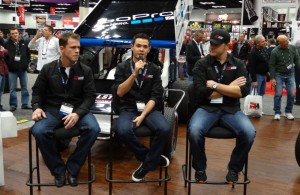Weekly Short Tracks Part Of American History
- Updated: June 25, 2008
DAYTONA BEACH, Fla. (June 25, 2008) – A little more than three-quarters of a century have passed since Richard M. Hollingshead, Jr. nailed a screen to a tree in his Camden, N.J., backyard and created the world’s first drive-in movie theater.
Hailed as part of Americana, the number of drive-ins peaked in 1958 when more than 4,000 theaters around the country entertained millions. Today, the number of active drive-ins is less than 800 and attendance is sparse.
Compare that rise and fall to the state of the weekly short tracks across the country. Hundreds of these racetracks dotted the countryside long before Hollingshead created a new form of entertainment, and many of these very same facilities survive today and still draw an enthusiastic crowd on a Friday or Saturday evening.
In fact, Jackson (Minn.) Speedway, an ASA Member Track, was first laid out sometime in the late 1800s making it one of the oldest racetracks in the United States. It has been in continual operation since becoming a weekly racetrack in 1954.
Bowman Gray Stadium, in Winston-Salem, N.C., was first sanctioned by NASCAR in 1949. This legendary quarter-mile racetrack still draws legions of fans for the Modified races that are held at “NASCAR’s longest running weekly race track.”
Weekly racetracks are the backbone of motorsports in the United States. Virtually all of today’s stars grew up racing at the local bullrings from coast to coast and border to border around the United States. Matt Kenseth visited victory lane at long-time ASA Member Track Madison (Wis.) International Speedway more times than his trophy case will handle. Langley Speedway in Hampton, Va., saw Denny Hamlin win both his first stock car pole and race – in his very first stock car start. And Joey Logano, recently making waves for Joe Gibbs Racing, made his professional debut in the former ASA National Tour at Lanier National Speedway near Atlanta.
The important thing to note is that virtually all of the weekly racetracks operate solely with private funding. Each week, America’s short tracks total attendance can reach five times, or higher, than the attendance of a NASCAR Sprint Cup race and stacks-up favorably against the combined attendance of the NFL, MLB and virtually all other professional sports. Yet, from 1953 to 1970 a total of 30 professional sports stadiums were built with all but three receiving taxpayer support (to the tune of $450 million, nearly 70 percent of the total cost of the 30 facilities). The number is increasing today with several new stadiums under construction, renovation, or topics of discussion.
“If you sit back and think about it, what the weekly short tracks across the country have done over their history is incredible, and all on their own dime so to speak,” said Dennis Huth, president of the American Speed Association which operates the growing ASA Member Track program. “They open their gates week-in and week-out, upgrade their facilities, promote their show, and develop the heroes of tomorrow all without any support whatsoever other than what their own wallet allows. And even more of a travesty, most of the time they do this without any thanks. The short tracks are an iconic part of the American sports landscape and have been the first introduction to racing for millions of fans and their passion for the sport.”
The track operators do this because of their own passion for the sport, and a desire to see it pass on to the next generation. A perfect example of this dedication can be found in Jim Borden, owner of ASA Member Track Hartford (Mich.) Motor Speedway.
“Hartford was sort of like an old high school sweetheart, or a first car, to Jim. It really holds a very special place in his heart. When he saw what had been going on recently at the racetrack, and heard the rumors that it could be closed down, he became concerned for the future and decided to do whatever it took to make sure the racetrack would still be there for a long time to come,” explained Rob Goodman, Hartford Motor Speedway promoter.
“Yes, Jim Borden is certainly a ‘feel good’ story about a guy who raced at a track for years and then came in and helped save it from extinction, but I hardly think that his is an unusual story. People like Jim are working at short tracks all over the country trying to keep the gates open, the fans entertained, and offer the drivers a safe place to compete. And they do it for little more than personal satisfaction and the knowledge that they are making a difference in their community and in the lives of the people who come to the track, either as a fan or a competitor,” Huth added.
There are over 1000 racetracks in operation today, and just like the drive-in theater, the short track is considered a vital part of America’s history. Some are sanctioned by the American Speed Association, some by NASCAR, and many are simply operated by the promoters themselves. But the one thing they all have in common is that they represent the backbone of motorsports today.
The ASA Member Track program is available to race track owners and promoters who choose to become part of the group that is working to develop new and innovative programs for the short track racing community. Whether you are a diehard race fan, a competitor, or just a casual observer, visit your local short track this summer and become a part of America’s history.
To learn more of the Daytona Beach, Fla.-based ASA Racing Member Track program, call (386) 258-2221 or send an e-mail to info@asa-racing.com. For news and information from all the racetracks and regional tours involved in the ASA, visit www.ASA-Racing.com.





![Porsche Fabcar crosses the finish line. [Robert Madara photo]](https://racingnation.com/wp-content/uploads/2023/11/FabcarFinish-108x70.jpeg)

![USF2000 Pro driver Lindsay Brewer. [Eddie LePine Photo]](https://racingnation.com/wp-content/uploads/2023/06/IMG_8825_2-108x70.jpg)